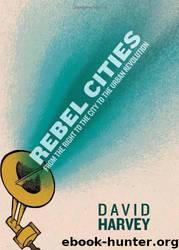Rebel Cities by David Harvey

Author:David Harvey
Language: eng
Format: mobi
Tags: City Planning & Urban Development, Political Ideologies, Social Science, Social Justice, General, Anti-Globalization Movement, Case Studies, Political Science, Communism, Public Policy, Capitalism, Post-Communism & Socialism
ISBN: 9781844678822
Publisher: Verso
Published: 2012-04-03T22:00:00+00:00
CHAPTER FOUR
The Art of Rent
The number of workers engaged in cultural activities and production has increased considerably over the past few decades (from some 150,000 artists registered in the New York metropolitan region in the early 1980s to likely more than double that by now), and continues to rise. They form the creative core of what Daniel Bell calls “the cultural mass” (not the creators but the transmitters of culture in the media and elsewhere),1 and have shifted in their political stances over the years. In the 1960s, the art colleges were hotbeds of radical discussion, but their subsequent pacification and professionalization has seriously diminished agitational politics. Though socialist strategy and thought may need to be reconfigured, revitalizing such institutions as centers of political engagement and mobilizing the political and agitational powers of cultural producers is surely a worthwhile objective for the left. While commercialization and market incentives unquestionably dominate in these times, there are plenty of dissident sub-currents and discontents to be detected among cultural producers to make this a fertile field for critical expression and political agitation for the production of a new kind of commons.
That culture is a form of commons, and that it has become a commodity of some sort, is undeniable. Yet there is also a widespread belief that there is something so special about certain cultural products and events (be they in the arts, theater, music, cinema, architecture, or more broadly in localized ways of life, heritage, collective memories, and affective communities) as to set them apart from ordinary commodities like shirts and shoes. While the boundary between the two sorts of commodities is highly porous (perhaps increasingly so), there are still grounds for maintaining an analytic separation. It may be, of course, that we distinguish cultural artifacts and events because we cannot bear to think of them as anything other than authentically different, existing on some higher plane of human creativity and meaning than that located in the factories of mass production and consumption. But even when we strip away all residues of wishful thinking (often backed by powerful ideologies), we are still left with something very special about those products designated as “cultural.” Art studio and gallery districts, and strips of cafés and bars where musicians meet and play, are not the same as clothing stores simply because they too can only exist if they turn enough profit to pay their rent. How, then, can the commodity status of so many of these phenomena be reconciled with their special character?
Download
This site does not store any files on its server. We only index and link to content provided by other sites. Please contact the content providers to delete copyright contents if any and email us, we'll remove relevant links or contents immediately.
| Anarchism | Communism & Socialism |
| Conservatism & Liberalism | Democracy |
| Fascism | Libertarianism |
| Nationalism | Radicalism |
| Utopian |
The Secret History by Donna Tartt(16608)
The Social Justice Warrior Handbook by Lisa De Pasquale(11485)
Thirteen Reasons Why by Jay Asher(7782)
This Is How You Lose Her by Junot Diaz(5753)
Weapons of Math Destruction by Cathy O'Neil(5029)
Zero to One by Peter Thiel(4817)
The Myth of the Strong Leader by Archie Brown(4785)
Promise Me, Dad by Joe Biden(4440)
Stone's Rules by Roger Stone(4412)
Beartown by Fredrik Backman(4403)
How Democracies Die by Steven Levitsky & Daniel Ziblatt(4392)
The Fire Next Time by James Baldwin(4336)
100 Deadly Skills by Clint Emerson(4070)
A Higher Loyalty: Truth, Lies, and Leadership by James Comey(4024)
Rise and Kill First by Ronen Bergman(4008)
The David Icke Guide to the Global Conspiracy (and how to end it) by David Icke(3875)
The Farm by Tom Rob Smith(3869)
Secrecy World by Jake Bernstein(3773)
The Doomsday Machine by Daniel Ellsberg(3725)
